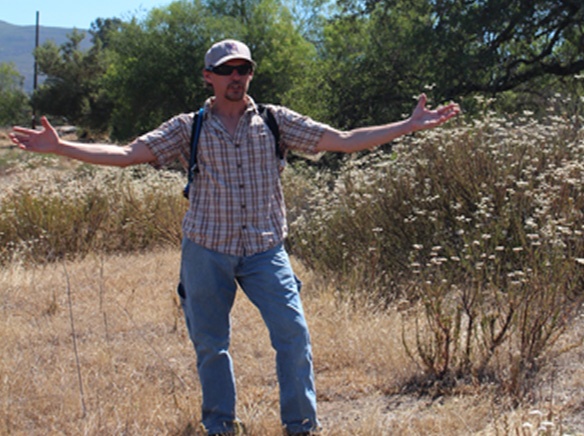On Saturday morning, Back Country Land Trust Program Director Jon Green finally had a chance to show off a 15-acre stretch of land donated by Darryl Priest as an extension to Wright’s Field back in 2019 that has waited through the pandemic for visitors.
Green gathered participants on Alpine Boulevard, just across from Olivewood Lane and, using photos from the Alpine Historical Society as evidence, explained how building remains found on the new property can be tied together with documented history to paint a picture of Alpine life circa 1899.
“Picture this: you take the train from San Diego to Lakeside, then it’s a two-day ride over rough terrain to get to Alpine. Arnold Way wasn’t named for Benjamin Arnold yet, it was still just called ‘the Grade’ before South Grade Road existed,” Green said.
After leading attendees across the street to Olivewood Lane and past the McNeil Ranch, Green paused at an access point to the new property and said “this would have been a premier piece of land in 1899” on the main thoroughfare with close proximity to downtown Alpine.
The McNeil estate itself is a link to days gone by— once an Arabian horse farm, the property was narrowly saved from being developed into 64 modern homes by two families who purchased the historic property. Just up the road is a creek wash with a concrete embankment stamped “1932”, one of several water sources Green said would have benefited the original homeowners.
A row of juniper trees likely indicate where a fence once stood on the newly donated property and, in combination with old fencing, lay out a rough perimeter of a large property line.
“The first thing to do with this new property is to obtain a proper archaeological survey. I keep wondering what treasures will turn up,” Green mused, then pointing to long-dead plants deliberately planted with equidistant spacing, he said they appear to have been planted to frame a long-gone doorway.
A dry concrete container about the size of a modern truck bed once served as a holding tank for water, Green believes, evidenced by the rusted pipes at a lower point on the property, and gravity likely worked in favor of the family that lived there to provide running water.
“You can see history right here,” Green said, standing on top of what he described as stairs but no house.
A group of boulders shaded modern, dumped junk and small pieces of what might be garbage, or historical artifacts.
“This is where the archaeologist comes in to tell me: is it garbage or not garbage,” Green said, in a wry tone.
Squared off fenced pens indicate where animals might have been kept and weathered telephone poles show that families lived on the acreage well into modern times. Green suspects the main home burned down in the 1970 Laguna Fire, a possibility that is corroborated by a lady he says remembers playing “Cowboys and Indians” in the back field decades earlier.
The fact that children were playing such a game on the very land where Kumeyaay ancestors once lived was not lost on him.
“Almost every large stone has milling on it, like Kumeyaay used them as tools,” Green said, running his hand gently over a gray boulder.
Pointing to what he calls a “dry stone wall”, Green said the technique indicates that someone used the materials they had on hand to create what would have been a decorative space for themselves, perhaps a sitting area under a tree, and helps craft the suggested shape of a front yard.
“This property looks barren now but it wasn’t that long ago that people lived out here,” Green said.














